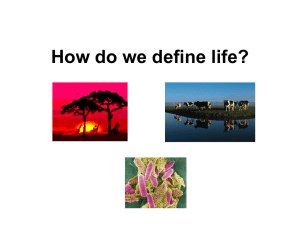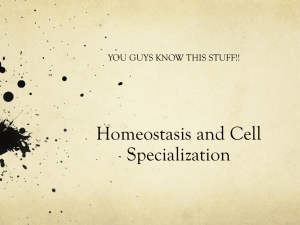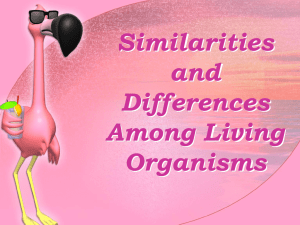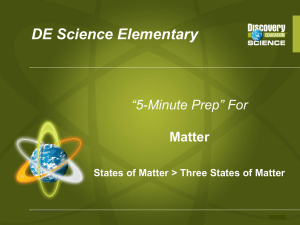Big Idea 2 - tasokapbiology
advertisement
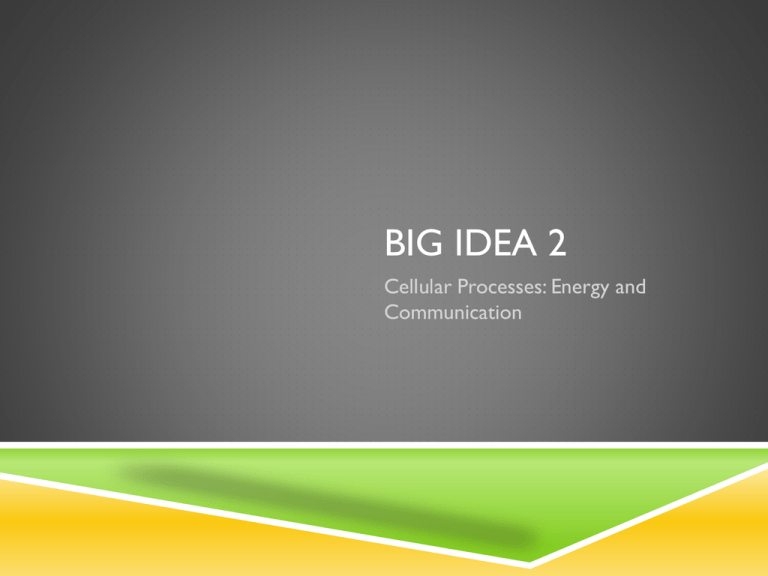
BIG IDEA 2 Cellular Processes: Energy and Communication ESSENTIAL QUESTIONS How is the cell the basic unit of life? How do materials enter and leave the cell? What role does the cell membrane play in cellular homeostasis? What are the relationships between structure and function of cell organelles? How are the characteristics of life manifested by the cell? How is free energy used in biological systems to facilitate growth, reproduction, and homeostasis sustainability? How is energy stored in biological systems? How are external signals converted into cellular responses? DAY 1 (60 MINUTES) Bozeman Videos: A Tour of the Cell (Cells) Cellular Organelles (Cells) Compartmentalization (Cells) Bacteria (Diversity of Life) Required Readings: Always refer to “Pearson text correlations” on the wiki under “What You Need to Know” for exact pages that you are responsible for before you begin your readings Chapter 6 (pp. 98-112), 6.1, 6.6 and 6.7 not required Chapter 27 (pp. 556-560) LEARNING OBJECTIVES Explain how internal membranes and organelles contribute to cell functions (LO 2.13, SP 6.2) Make a prediction about the interactions of subcellular organelles (LO 4.4, SP 6.4) Construct explanations based on scientific evidence as to how interactions of subcellular structures provide essential functions (LO 4.5, SP 6.2) Use representations and models to analyze situations qualitatively to describe how interactions of subcellular structures, which possess specialized functions (LO 4.6, SP 1.4) ACTIVITY ONE Use the website “CELLS alive!” to construct a Venn diagram comparing eukaryotic and prokaryotic cells. Explain the evolutionary relationships and how the cellular organelles work together for homeostatic balance to maintain life. Time: 20 minutes ACTIVITY TWO Review the pictures of bacteria, plant and animal cells Compare the structures present in the different cell types What are required functions of cells? Predict and justify how the subcellular structures interact and provide essential functions How do the different types of cells subcellular structures differ with respect to the function of the cell? Time: 20 minutes ACTIVITY THREE Design a 3-D representation of a specific organelle Organelle should be no larger than 20cm You will present your organelle with an explanation of the role the organelle has in maintaining cell homeostasis Time: 20 minutes CLOSING ACTIVITY Quiz! Time: 15 minutes Question 1: What is the most likely pathway taken by a newly synthesized protein that will be secreted by a cell? A) ER – Golgi – Nucleus B) Nucleus – ER – Lysosome C) ER – Golgi – Vesicles that fuse with plasma membrane D) ER – Lysosome – Vesicles that fuse with plasma membrane Question 2: In 4-5 sentences, explain what is meant by this statement: Life is an emergent property (new properties that arise with each step upward in the hierarchy of life, owing to the arrangement and interactions of parts as complexity increases) that appears at the level of the cell. DAY 2 Required readings: Chapter 7 (pp. 125-138) Bozeman videos: The Cell Membrane (Cells) Why Are Cells Small (Cells) Transport Across Cell Membranes (Cells) LEARNING OBJECTIVES Use representations and models to pose scientific questions about the properties of cell membranes and selective permeability based on molecular structure (LO 2.10, SP 1.4, SP 3.1) Construct models that connect the movement of molecules across membranes with membrane structure and function (LO 2.11, SP 1.1, SP 7.1, SP 72.) Use representations and models to analyze situations or solve problems qualitatively to investigate whether dynamic homeostasis is maintained by the active movement of molecules across membranes (LO 2.12, SP 1.4) Use calculated surface area-to-volume ratios to predict which cell(s) might eliminate wastes or produce nutrients faster by diffusion (LO 2.6, SP 2.2) Explain how cell size and shape affect the overall rate of nutrient intake and the rate of waste elimination (LO 2.7, SP 6.2) ACTIVITY ONE Look at the vegetables on the desk in front of you. Are they still edible? What has caused them to wilt? Can this process be reversed? Suppose you have a houseplant that has wilted. Design an experiment to test whether or not this process can be reversed in a houseplant. Ideas to think about: Permeability of membranes Properties of the cell membrane Movement of molecules across a membrane Time: 25 minutes ACTIVITY TWO Create a visual representation (any way you want) to illustrate and explain examples of passive and active transport across the cell membrane. Be sure to include: The role of proteins in cellular transport Hypotonic, hypertonic and isotonic environments in plant and animal cells Movement of large molecules (exocytosis and endocytosis) When and how active transport is accomplished Time: 25 minutes ACTIVITY THREE Cells can not be indefinitely large. Why not? Design an experiment using potatoes and iodine to show the efficiency of 3 different sizes of “cells” Calculate the surface area-to-volume ratio (SA:V) for each of the cubes. Which SA:V ratio was the most efficient size? Does this correlate to the smallest cube or the biggest cube? Time: 25 minutes CLOSING ACTIVITY Quiz! Time: 15 minutes DAY 3 Required readings: Lab #4: Diffusion and Osmosis Bozeman videos: Osmosis lab walk-through (AP Bio Labs) Diffusion demo (AP Bio labs) Supplemental resources: AP Biology Lab Manual, Lab #1 AP Biology CD ROM, Lab #1 LEARNING OBJECTIVES Use representations and models to analyze situations or solve problems qualitatively to investigate whether dynamic homeostasis is maintained by the active movement of molecules across membranes (LO 2.12, SP 1.4) Use calculated surface area-to-volume ratios to predict which cell(s) might eliminate wastes or produce nutrients faster by diffusion (LO 2.6, SP 2.2) Explain how cell size and shape affect the overall rate of nutrient intake and the rate of waste elimination (LO 2.7, SP 6.2) LAB #4: OSMOSIS AND DIFFUSION You will be designing and conducting experiments to investigate the process of diffusion and osmosis in the transport of molecules across cell membranes You will analyze how SA:V ratios affect the rate of diffusion by measuring the movement of materials into a “cell” Required: CERR lab report for procedure 1, 2 and 3 Experimental design for procedure 3 Due next Wednesday Time: 90 minutes PROCEDURE 1: SURFACE AREA AND CELL SIZE Completed on Friday (a similar activity) Write down the steps you took in order to complete the experiment What were the variables? What was controlled (not what was the control)? What did you find? Which type of cell is most efficient? A large SA:V or a small SA:V? PROCEDURE 2: MODELING DIFFUSION AND OSMOSIS Read through Procedure 2 and discuss the IV questions with your partner, as well as the questions after the materials list Instead of dialysis tubing, use the plastic sandwich bags Instead of sucrose, we will use a starch solution Get the “cells” ready and place them into the beakers with water (take their mass first) Take their mass after you have completed the set up of procedure 3 Maximum time: 30 minutes PROCEDURE 3: OBSERVING OSMOSIS IN LIVING CELLS Discuss the questions with your partner before designing your experiment Omit part 1 Design an experiment that answers how solute concentration affects the water potential in potatoes There are 5 different solution concentrations, which are unknown to you How will you collect data, what data do you need to collect and how will you analyze it? You will come back tomorrow to measure the changes in your potato Discuss the questions with your partner to help aid your design Maximum time: 45 minutes WATER POTENTIAL: WHAT DOES IT MEAN? Water potential – the force that drives water to move in a given direction Solute concentration and pressure potential contribute to water potential Ψ = Ψp + Ψs Increased pressure potential = increased water movement Water moves from a region of higher water potential to a region of lower water potential until it reaches equilibrium As the solute concentration of the solution is increased, the amount of water that flows out of the cell will increase DAY 4 Required Readings: Chapter 2 (none is actually highlighted, but if you have not taken chemistry, it is a good idea to look over this chapter) Chapter 3 Chapter 4 (exclude pp. 63-66) Bozeman Videos: Water: A Polar Molecule (Water) Chemical Bonds: Ionic and Covalent (chemistry) (optional) The Molecules of Cells LEARNING OBJECTIVES Justify the selection of data regarding the types of molecules that an animal, plant, or bacterium will take up as necessary building blocks and excrete waste products (LO 2.8, SP 4.1) Explain the connection between the sequence and subcomponents of a biological polymer and its properties (LO 4.1, SP 7.1) Construct explanations based on evidence of how variation in molecular units provides cells with a wider range of functions (LO 4.22, SP 6.2) Represent graphically or model quantitatively the exchange of molecules between an organism and its environment, and the subsequent use of these molecules to build new molecules that facilitate dynamic homeostasis, growth, and reproduction (LO 2.9, SP 1.1, SP 1.4) ACTIVITY ONE What role do carbon and nitrogen play in the production of complex organic molecules such as amino acids (AA), protein (PRO) and nucleic acids (NA) in living organisms? To answer this question, you will work in a small group to complete one of the carbon cycle or the nitrogen cycle. Create a model or representation of either cycle Choose a particular ecosystem (biome) that your cycle is in For your ecosystem, what are the biotic and abiotic factors in the cycle? How do the biotic and abiotic factors keep the cycle going? Time: 25 minutes ACTIVITY TWO Look at the different beakers that are on the front desk. Write down any observations and questions that you have about the liquids that are in the beakers. You have been asked to test the different substances to find out which one is water.You can not smell it or taste it (one is toxic). Knowing the different properties of water, choose 3 that you will test to determine which one is water. Write down the steps and questions you will ask along the way. Time: 15 minutes ACTIVITY THREE You will be given a property of water to depict as a superhero for a comic strip Create a 5-panel comic strip that illustrates and explains the important role water has in a biological system You will explain and present your comic strip to the class Properties: Water can participate in hydrogen bonds because it is a polar molecule Cohesion Moderation of temperature Solid is less dense than liquid Universal solvent Time: 30 minutes CLOSING ACTIVITY Quiz! Time: 20 minutes DAY 5 Required Readings: Chapter 5 Bozeman Videos: Biological Molecules (Biochemistry) The Molecules of Life (Chemistry) LEARNING OBJECTIVES Explain the connection between the sequence and the subcomponents of a biological polymer and its properties (LO 4.1, SP 7.1) Construct explanations based on evidence of how variation in molecular unites provides cells with a wider range of functions (LO 4.22, SP 6.2) Represent graphically or model quantitatively the exchange of molecules between an organism and its environment, and the subsequent use of these molecules to build new molecules that facilitate dynamic homeostasis, growth and reproduction (LO 2.9, SP 1.1, SP 1.4) ACTIVITY ONE Create molecular models demonstrating the SPONCH elements that form the macromolecules important to the homeostasis of living systems Make sure your models can be manipulated to represent concepts such as dehydration, hydrolysis and synthesis You can draw your models on cue cards to help you remember Time: 20 minutes ACTIVITY TWO Look at the picture you have been given and answer the following question: Explain with justification the role of SPONCH elements in the environment depicted on your card and how they are integral parts of the macromolecules essential to living systems. Share your answer with someone who has a different picture than you. Time: 15 minutes ACTIVITY THREE Testing for macromolecules You will be given the following food samples: Egg, raw, hard boiled Vegetable oil Glucose Potato Unknown Devise a plan to test for the presence of the different macromolecules that may be present in the foods given ACTIVITY THREE (CONT’D) Test for starch: Iodine Test for glucose: Benedict’s solution Test for fat: paper towel Test for protein: NaOH and CuSO4 solution What are the results if it is positive? Negative? Time: 30 minutes ACTIVITY FOUR Look at the following food labels and create a graphic organizer to explain the role of macromolecules in the human body Fold the paper given to you in 4 and label each square with one of the macromolecules (CHO, fat, PRO, NA) Explain and justify how the food item will or will not supply the macromolecule sources to our bodies Describe the type of molecules our body requires as essential building blocks and why this particular food is necessary for homeostasis Present your findings to the class Time: 20 minutes CLOSING ACTIVITY Quiz! Time: 5 minutes DAY 6 (60 MINUTES) Required readings: Chapter 8 Bozeman videos: Chapter 5b Enzymes LEARNING OBJECTIVES Refine representations and models to explain how the subcomponents of a biological polymer and their sequence determine the properties of that polymer (LO 4.2, SP 1.2) Use models to predict and justify that change in the subcomponents of a biological polymer affect the functionality of the molecule (LO 4.3, SP 6.4) Analyze data to identify how molecular interactions affect structure and function (LO 4.17, SP 5.1) ACTIVITY ONE LabBench Activity: Enzyme Catalysis http://www.phschool.com/science/biology_place/labbench/lab2/intro.html Look over the various concepts for enzymes Read through the design of the lab Time: 20 minutes ACTIVITY TWO Get into a group of 4 I will give you either an endergonic or exergonic reaction to act out, either in a skit, a poem, a song, etc. In your play, be sure to show whether or not: Energy is absorbed or released The reaction is spontaneous or not If bonds are broken or formed If ATP is used, and where An example Time: 25minutes for planning, 5 minutes for acting CLOSING ACTIVITY Quiz! Time: 10 minutes DAY 7 Required Readings: None Bozeman Videos: Lab #2: Enzyme Catalysis Supplemental Readings AP Bio lab manual lab #2 LEARNING OBJECTIVES Refine representations and models to explain how the subcomponents of a biological polymer and their sequence determine the properties of that polymer (LO 4.2, SP 1.2) Use models to predict and justify that change in the subcomponents of a biological polymer affect the functionality of the molecule (LO 4.3, SP 6.4) Analyze data to identify how molecular interactions affect structure and function (LO 4.17, SP 5.1) LAB: ENZYMES HELP US BREAK DOWN HARMFUL SUBSTANCES The enzyme catalase is present in our bodies and helps break down hydrogen peroxide (toxic) into water and oxygen: 2H2O2 O2 + 2H2O You will be given 100% catalase, as well as some liver for your experiment. You need to decide with your partner what you are going to test, and devise a plan to test it Show me your plan before you begin your experiment Time: 90 minutes DAY 8 Required Readings: Chapter 6 (6.2, 6.3, 6.4, 6.5) Chapter 25 (exclude 25.6) Chapter 26 (exclude 26.4, 26.5) Bozeman Videos: Essential Characteristics of Life are Conserved LEARNING OBJECTIVES Justify the scientific claim that organisms share many conserved core processes and features that evolved and are widely distributed among organisms today (LO 1.16, SP 6.1) Pose scientific questions that correctly identify essential properties of shared, core life processes that provide insights into the history of life on Earth (LO 1.14, SP 3.1) ACTIVITY ONE Look at the pictures/micrographs of the following items: Mitochondria Chloroplast Linear chromosomes Nuclear envelope What do you notice about these pictures? What can you deduce from these pictures? What role do these organelles have in the functioning of the cell? How do they maintain homeostasis? Time: 15 minutes ACTIVITY TWO Research Lynn Margulis’ hypothesis of endosymbiosis (20 minutes) Work in a group of 4 to pool your information that you have gathered (15 minutes) How would the endosymbiont lose its autonomy and become an organelle in eukaryotic cells? Provide examples and justify evidence supporting the endosymbiotic theory for the origin of eukaryotes Provide evidence to refute Margulis’ hypothesis that prokaryotes gave rise to eukaryotes We will have a class discussion about what you have found (10 minutes) Time: 45 minutes total ACTIVITY THREE Create a visual representation (comic strip, concept map, model, etc.) to show the theory of endosymbiosis Present to the class Time: 20 minutes CLOSING ACTIVITY Quiz! Time: 10 minutes DAY 9: UNIT TEST Topics covered: Water & the Fitness of the Environment (3) Carbon & the Molecular Diversity of Life (4) The Structure and Function of Large Biological Molecules (5) A Tour of the Cell (6) Membrane Structure and Function (7) An Introduction to Metabolism (8) Prokaryotes (27.1) Evolution of Eukaryotes from Prokaryotes (6,25, 26) DAY 10 Required Readings: Chapter 8, 9, 10 Bozeman Videos: Cellular Respiration LEARNING OBJECTIVES Explain how biological systems use free energy based on empirical data that all organisms require constant energy input to maintain organization, to grow, and to reproduce (LO 2.1, SP 6.2) Justify a scientific claim that free energy is required for living systems to maintain organization, to grow, or to reproduce, but that multiple strategies exist in different living systems (LO 2.2, SP6.1) Predict how changes in free energy availability affect organisms, populations, and ecosystems (LO 2.3, SP 6.4) ACTIVITY ONE Research how fermentation occurs in yogurt cheese, chocolate, vinegar, or sourdough bread (each group choose a different food) Write a 2-3 page paper using the following questions as a guide: What metabolic pathway is used in the fermentation process? What substrate is involved in the process? What are the products that result from the process? How is fermentation accomplished? How is the product prepared for consumption? Due: Friday, September 14 Time: 40 minutes ACTIVITY TWO Design and conduct an experiment to investigate how yeast metabolizes different sugars Question: Which treatment will produce the most carbon dioxide? Warm water + yeast Yeast + glucose Yeast + table sugar Materials: Balloons, water bottles, string, yeast (dry active) Time: 40 minutes CLOSING ACTIVITY Quiz! Time: 5 minutes DAY 11 Required Readings: AP Biology lab #6: Cellular Respiration Bozeman Video AP Bio lab #5 LEARNING OBJECTIVES Construct explanations of the mechanisms and structural features of cells that allow organisms to capture, store, or use free energy (LO 2.5, SP 6.2) ACTIVITY ONE Cellular Respiration lab Time: 60 minutes DAY 12 Required Readings: Chapter 8, 9, 10 Bozeman videos: Photosynthesis LEARNING OBJECTIVES Use representations and models to analyze how cooperative interactions within organisms promote efficiency in the use of energy and matter (LO 4.18, SP 1.4) Use representations to pose scientific questions about what mechanisms and structural features allow organisms to capture, store, and use free energy (LO 2.4, SP 1.4, SP 3.1) Describe specific examples of conserved core biological processes and features shared by all domains or within one domain of life, and how these shared, conserved core processes and features support the concept of common ancestry for all organisms (LO 1.15, SP 7.2) ACTIVITY ONE Read the article provided about how herbicides block the metabolic pathways for photosynthesis Write down scientific questions after reading the article Construct explanations (and justify) regarding how mechanisms and structural features of the plant disallow the plan to capture, store, or use free energy Time: 45 minutes ACTIVITY TWO Create a poster to explain the interdependent relationships of cellular respiration and photosynthesis How would these processes affect a runner in a marathon race? Be sure to make use of graphics to represent the cyclic process Time: 30 minutes CLOSING ACTIVITY Quiz! Time: 15 minutes DAY 13 Required Readings: AP Bio lab #5 Bozeman videos: AP Bio lab #4: Photosynthesis LEARNING OBJECTIVES Use representations to pose scientific questions about what mechanisms and structural features allow organisms to capture, store, and use free energy (LO 2.4, SP 1.4, SP 3.1) Describe specific examples of conserved core biological processes and features shared by all domains or within one domain of life, and how these shared, conserved core processes and features support the concept of common ancestry for all organisms (LO 1.15, SP 7.2) ACTIVITY ONE What are different factors that affect the rate of photosynthesis? Choose 1 factor to test and design an experiment to test this factor Time: 80 minutes CLOSING ACTIVITY Quiz! Time: 10 minutes DAY 14 Required Readings: Chapter 11 Bozeman Videos: 036 037 038 039 LEARNING OBJECTIVES Describe basic chemical processes for cell communication shared across evolutionary lines of descent. [LO 3.31, SP 7.2] Generate scientific questions involving cell communication as it relates to the process of evolution. [LO 3.32, SP 3.1] Use representation(s) and appropriate and models to describe features of a cell signaling pathway. [LO 3.33, SP 1.4] Construct explanations of cell communication through cell-to-cell direct contact or through chemical signaling. [LO 3.34, SP 6.2] Create representation(s) that depict how cell-to-cell communication occurs by direct contact or from a distance through chemical signaling. [LO 3.35, SP 1.1] Describe a model that expresses the key elements of signal transduction pathways by which a signal is converted to a cellular response. [LO 3.36, SP 1.5] Justify claims based on scientific evidence that changes in signal transduction pathways can alter cellular response. [LO 3.37, SP 6.1] Describe a model that expresses key elements to show how change in signal transduction can alter cellular response. [LO 3.38, SP 1.5] Construct an explanation of how certain drugs affect signal reception and, consequently, signal transduction pathways. [LO 3.39, SP 6.2] ACTIVITY ONE Go to the website http://learn.genetics.utah.edu/content/begin/cells/ How do cells communicate through signals aided by pahtways made of proteins? View 3-D animations for cell communication, the fight or flight response Examine how cells communicate during this response Complete the “Dropping Signals” What happens when cell communication goes wrong? Time: 75 minutes CLOSING ACTIVITY Quiz Time: 15 minutes DAY 15 Required Readings: Chapter 11 Bozeman Videos: 036 037 038 039 LEARNING OBJECTIVES Describe basic chemical processes for cell communication shared across evolutionary lines of descent. [LO 3.31, SP 7.2] Generate scientific questions involving cell communication as it relates to the process of evolution. [LO 3.32, SP 3.1] Use representation(s) and appropriate and models to describe features of a cell signaling pathway. [LO 3.33, SP 1.4] Construct explanations of cell communication through cell-to-cell direct contact or through chemical signaling. [LO 3.34, SP 6.2] Create representation(s) that depict how cell-to-cell communication occurs by direct contact or from a distance through chemical signaling. [LO 3.35, SP 1.1] Describe a model that expresses the key elements of signal transduction pathways by which a signal is converted to a cellular response. [LO 3.36, SP 1.5] Justify claims based on scientific evidence that changes in signal transduction pathways can alter cellular response. [LO 3.37, SP 6.1] Describe a model that expresses key elements to show how change in signal transduction can alter cellular response. [LO 3.38, SP 1.5] Construct an explanation of how certain drugs affect signal reception and, consequently, signal transduction pathways. [LO 3.39, SP 6.2] ACTIVITY ONE Create a model to illustrate the key features/components in a G-protein receptor system and the three stages of signaling: reception, transduction and cellular response Time: 30 minutes ACTIVITY TWO Create a poster that shows the steps in a signal transduction pathway Time: 35 minutes CLOSING ACTIVITY Quiz! Create 3 questions (1 MC, 2 short answer) for a quiz DAY 16 Unit test #2 Topics covered: Chapter 3, 4, 5, 6, 7, 8, 9, 10, 11, 25, 26, 27 Lab #4, 5, 6
